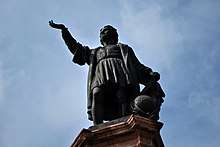Monument to Christopher Columbus (Paseo de la Reforma)
The Monument to Christopher Columbus (Spanish: Monumento a Colón), on a major traffic roundabout (glorieta) along Mexico City's Paseo de la Reforma, was dedicated in 1877.[1]
| Monument to Christopher Columbus | |
|---|---|
| Spanish: Monumento a Colón | |
 Monument along Paseo de la Reforma | |
%26groups%3D_fafed91225fd67246c247c4883352d203899d704.svg)
| |
| Artist | Charles Cordier |
| Year | 1877 |
| Subject | Christopher Columbus |
| Location | Mexico City, Mexico |
| 19.4330870°N 99.154760°W | |
History
The statue was part of a plan to embellish the major thoroughfare with statues of persons of historical significance to Mexico. The work was a gift to the capital of the entrepreneur, Antonio Escandón, a member of a wealthy, conservative Mexican family and who had supported Emperor Maximilian, built the Mexico City-Veracruz railway with the help of French investments and British engineers.[2] The railway linked the inland capital with its main east coast port. Escandón "decided to commemorate the era of the railroad in Mexico with a monument to an equally epochal event, the Discovery of the New World."[3]
In 1873, Escandón commissioned French sculptor Charles Cordier to design and execute the statue, which was shipped to Mexico for installation. The statue was inaugurated almost immediately after liberal General Porfirio Díaz seized the presidency in 1876. The Cordier sculpture has been described as the construction of a monument "manipulated by a Mexican industrialist for greater economic ties with foreign investors."[4] It was originally to be placed in front of the Buenavista train station in Mexico City.[5] The statue had already been commissioned and sculpted in France, arriving in Veracruz in 1875. It was installed in 1877 under the supervision of Mexican engineer, Eleuterio Méndes.[6]
Description

On the monument's pedestal are two bas-reliefs, one depicting showing Christopher Columbus's arrival in the New World and the other, the construction of a church. On the corners of the pedestal are statues of friars, depicted in a seated position, said to be those who were important to the early history of Mexico including Franciscan Pedro de Gante, the first to evangelize Mexico's indigenous population, and Dominican Bartolomé de las Casas; and Antonio de Marchena and Diego de Deza, who aided Columbus in Spain.
As with "almost all the [Columbus] monuments, the gift or inspiration of Europeans or Europeans of mixed descent, include some reference to religion."[7] In Mexico, where anticlericalism and suppression of the power of the Catholic Church had embroiled Mexico in a civil war and a foreign intervention during the nineteenth-century liberal Reform, the Columbus statue's combination of religious iconography and symbolic embodiment of European conquest and domination, has made the statue a target of protesters.[8] One scholar suggests that Columbus "is portrayed as a conqueror, or even a conjurer, for he plucks a veil from the globe he holds."[9]
References
- Cocking, Lauren. "A Guide To Mexico City's 15 Most Important Statues and Monuments". Culture Trip. Retrieved 2018-11-23.
- Oscar E. Vázquez, "Translating 1492: Mexico's and Spain's First National Celebrations of the 'Discovery' of the Americas." Art Journal Vol. 51, No. 4, Latin American Art (Winter, 1992), pp. 21-29. Stable URL: https://www.jstor.org/stable/777281 accessed 3 February 2019.
- Claudia Agostoni, Monuments of Progress: Modernization and Public Health in Mexico City, 1876-1910. University of Calgary Press 2003, p. 95.
- Vázquez, "Translating 1492", p. 24.
- Luis García Pimentel, El Monumento elevado en la ciudad de México a Crisóbal Colón. Mexico: Imprenta de Francsco Díaz de León 1879 p. 13, cited in Vázquez, "Translating 1492" p. 29.
- Barbara Tenenbaum, "Streetwise History: The Paseo de la Reforma and the Porfirian State" in Rituals of Rule: Rituals of Resistance: Public Celebrations and Popular Culture in Mexico, ed. William Beezley et al. Rowman and Littlefield 1994, p. 131.
- Barbara Groseclose,"Monuments and Memorials", The Christopher Columbus Encyclopedia, Simon and Schuster 1992, vol. 2 p. 481.
- Groseclose, "Monuments and Memorials", p.481.
- Groseclose, "Monuments and Memorials", p. 481.
External links
